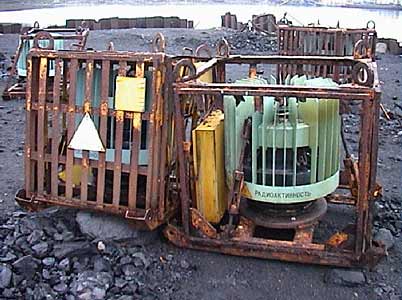Russia has almost entirely rid itself of more than 1,000 small radioactive power sources that have for nearly half a century powered navigational beacons, lighthouses and meteorological outposts along its arctic coasts and deep in its hinterlands, a division of Russian state nuclear corporation Rosatom has said.
Russia has almost entirely rid itself of more than 1,000 small radioactive power sources that have for nearly half a century powered navigational beacons, lighthouses and meteorological outposts along its arctic coasts and deep in its hinterlands, a division of Russian state nuclear corporation Rosatom has said.
Called radioisotope thermoelectric generators, or RTGs, many of the power sources, which contain strontium 90, turned through decades of neglect into orphaned radiological hot spots.
Though Russia is far from the only country to put this technology to use, the fall of the Soviet Union made them especially problematic, as Russian authorities lost track of many of the units because their records disappeared during the political shift.
Through most of the 1990s, evidence of their dangers would surface in the form of outdoorsmen turning up at hospitals with telltale radiation burns after happening upon RTG’s in their remote locations.
 Another Russian model RTG. (Photo: IAEA)
Another Russian model RTG. (Photo: IAEA)
They also fell prey to metal thieves who would scavenge their shielding and expose or discard their strontium 90 pits.
The units also posed serious international security threats. Because of their typically out-of-the-way locations, they could have become attractive to terrorists hunting for dirty bomb components.
Now, according to Valery Berdnikov of the Scientific Research Institute for Technical Physics and Automation, a division of Rosatom, 80 percent of these radiological mines have been removed from service as a result of years of work on mapping their locations.
Berdnikov’s institute initially developed various Soviet RTGs designs between 1960 and 1980.
Sizeable international funds poured into Russia in the early 2000s to help locate and immobilize orphaned RTGs, and in many cases replace more crucial ones with solar energy.
Norway alone helped immobilize 180 RTGs along the coasts of the Barents, White and Kara Seas. Relying on its own experience with RTGs along its 50,000 kilometer coastline, Norway replaced the strontium-based energy source in the Russian RTGs with solar installations.
Converting these Northwest Russian RTGs cost €20 million. Another 55 RTGs were removed from the Russian enclave of Kaliningrad, on the Baltic Sea, and from the Gulf of Finland at a cost of €6 million.
Per-Einar Fiskebeck, the chief engineer for Norway’s northerly Finnmark Country, who headed up the RTG conversions, said they came off without a hitch.
“I am very proud that over this time we have managed to remove 30 million curies [of radiation],” he told those assembled at the AtomEco forum in Moscow last week. “I am glad that Northwest Russia and the Baltic have been made cleaner and have been rid of RTGs.”
International Assistance
Aside from Norway, Canada, the United States, France and other EU countries offered their assistance to Russia in dealing with rash of RTGs.
Like the example of those handled by Norway, Berdnikov said the task of dealing with the wider problem included not only locating the devices and taking out their strontium 90 powered generators. Those RTGs powering lighthouses and navigation beacons also had to be fitted with other energy sources.
The United States and Russia, in particular, signed a long-negotiated 2003 agreement to evacuate RTGs belonging to Russia’s Ministry of Transport that were located along the Northern Sea Route off Russia’s Arctic coast.
 A dilapidated housing for a meteorological RTG unit in Russia. (Photo: Bellona)
A dilapidated housing for a meteorological RTG unit in Russia. (Photo: Bellona)
The cooperative project was subsequently broadened to include removing Russian Naval RTGs in Russia’s remote Far East.
Steven Porter, lead engineer at California’s Lawrence Livermore Laboratory told the AtomEco forum that 196 RTGs were found along Russia’s Pacific Coast. American funding in 2006 built an installation for Russia’s Far East nuclear waste handler DalRAO, which is suitable for the temporary storage of 250 RTGs for up to 50 years.
The US and Russia also worked together to neutralize another 486 RTGs. This was, according to Porter one of the most difficult elements of the cooperative project because there was no data either on the number or even the location of the units.
“While completing the project, Russia and the US jointly neutralized 486 RTGs and produced 295 alternative energy sources” to run them, said Porter.
In the same timeframe, the US cooperated with Russia to remove four RTGs from Antarctica.
Berdnikov said of the 80 percent of the RTGs that have currently been neutralized, part of them have been dismantled by Rosatom subsidiary Isotope, which deals in isotope production and radiological threat reduction.
Another portion of the neutralized RTGs have been sent for long-term storage at the Mayak Chemical Combine in Russia’s Chelyabinsk Region, he said, and still others remain at in the DalRAO storage facility in the Far East.
There are still 12 RTGs in operation on the far-flung Kamchatka Peninsula. Another in Sakhalin has not yet been located.
“I would like to thank all countries that helped us to solve our problems,” said Anatoly Grigoriev, head of Rosatom’s department for international project coordination. “We are very glad the issue of RTGs is nearly solved.”






